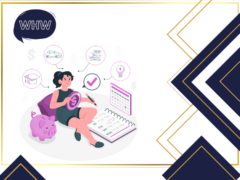What is Revolving Credit?

Imagine you’re at a café with your laptop open, planning your monthly budget. As you tally the numbers, you realize some unexpected expenses might pop up soon, this is where revolving credit steps into the spotlight.
It’s not just a financial term, it’s a flexible friend that adapts to your financial ebbs and flows, helping you manage those surprises without a hitch.
Why should you care? Because revolving credit is pivotal in balancing your financial wellness and boosting your credit score, all while giving you the breathing room to handle money on your terms.
In this guide, we’ll unwrap the layers of revolving credit, what it is, how it benefits you, and why it could be a cornerstone of savvy financial planning.
From understanding its revolving credit meaning to seeing it in action across various revolving credit examples, we’re setting the stage for you to master its use and optimize your revolving credit utilization.
Let’s begin this journey into the world of revolving credit, where flexibility meets financial security.
What is Revolving Credit?
Revolving credit is akin to having a reservoir of funds you can tap into whenever you need, without reapplying each time you withdraw. It’s a dynamic financial tool around money being borrowed, spent, repaid, and then available again.
Picture it as a revolving credit line from your bank: You’re given a revolving credit limit, say $5,000, and you can use up to this amount whenever necessary.
How does it function in everyday life? Let’s say you use $2,000 for an unexpected repair. You now have $3,000 left to use, but as you pay back the $2,000, your available credit returns to the original $5,000, ready to be used again.
The catch? Each month, you must make at least a minimum payment on the borrowed amount. Not just for easing cash flow, revolving credit also requires discipline to manage effectively.
What sets revolving credit apart from its cousin, the installment loan? While installment loans provide you with a lump sum that’s repaid in fixed payments over a set period, think mortgages or auto loans, revolving credit is fluid.
It offers flexibility and continual access to funds, which installment loans don’t, making it perfect for ongoing, varied expenses.
This distinction highlights why understanding revolving credit can be pivotal for strategic financial planning, especially in managing fluctuating costs and ensuring you always have access to funds when you need them most.
Revolving Credit in Action: Real-Life Examples
Revolving credit adapts seamlessly to the ebb and flow of our financial lives, appearing in various forms to suit different needs and lifestyles:
- Credit Cards: These are the daily warriors of revolving credit, stepping in for everything from your morning coffee to emergency car repairs. The beauty of credit cards lies in their ability to stretch your financial capability, allowing you to pay over time, which can be a lifesaver during tight budget months.
- Home Equity Lines of Credit (HELOCs): Tailored for homeowners, HELOCs offer a way to tap into the equity you’ve built up in your home. This can be particularly handy for big projects or life events, like renovating your kitchen or covering college tuition, potentially increasing your home’s value and providing some tax advantages.
- Personal Lines of Credit: These are often the unsung heroes for freelancers and small business owners, helping to smooth out the unpredictable nature of self-employed earnings. This flexibility is key for covering ongoing expenses or jumping on unexpected business opportunities without having to rely on high-interest credit options.
The flexibility of revolving credit is undeniable, but it’s not without its temptations. Easy access can lead to overspending, and the interest on balances carried over from month to month can inflate your expenses over time.
Being strategic and mindful about using revolving credit can help you leverage its benefits while avoiding potential financial pitfalls.
Understanding Revolving Credit Utilization and Its Importance
Credit utilization measures how much of your available credit you are using and is a critical factor in your credit score.
Here’s how understanding and managing your utilization can impact your financial health:
- Keeping Utilization Low: It’s wise to keep your utilization below 30% of your total credit limit. This signals to creditors that you’re using your credit responsibly and not overextending yourself financially.
- Strategies for Managing Utilization:
- Make Multiple Payments: Instead of paying monthly, consider biweekly payments to keep your balances low throughout the month.
- Request Higher Credit Limits: If your financial situation allows, ask for increased limits on your credit lines. A higher credit limit can dilute your utilization ratio, provided you don’t increase your spending.
- Spread Your Charges: Use multiple credit accounts for different types of purchases to distribute your debt more evenly and avoid maxing out any single account.
Actively managing your credit utilization can boost your credit score, secure you better-borrowing terms, and ultimately affirm your creditworthiness to lenders.
Regular review and adjustment of your credit use, in line with your broader financial goals, are essential to harnessing the full advantage of your revolving credit.
Pros and Cons of Revolving Credit
Revolving credit is a double-edged sword, offering significant flexibility but also potential pitfalls.
Here’s how to navigate these waters effectively:
Benefits
- Flexibility: Revolving credit lines, such as credit cards and lines of credit, allow you to borrow repeatedly up to a set limit and repay over time, providing great flexibility in managing cash flow.
- Immediate Access: Unlike traditional loans, once approved for revolving credit, you can access funds immediately and for any purpose without needing to reapply.
- Rewards and Perks: Many credit cards offer rewards like cash back, travel points, or other benefits based on your spending, which can add significant value if used wisely.
Drawbacks
- High-Interest Rates: Revolving credit can come with higher interest rates, particularly if balances are carried over month to month, which can significantly increase the cost of borrowed funds.
- Temptation to Overspend: The ease of accessing credit can lead to spending beyond your means, which can spiral into unmanageable debt levels.
- Credit Score Impact: Mismanaging revolving credit by accruing high balances or making late payments can negatively affect your credit score.
Practical Advice
- Set Spending Limits: Treat your credit limit not as a target but as a maximum boundary and aim to spend well below it.
- Pay Balances in Full: Avoid interest charges and build a positive credit history by paying off your balances each month.
- Monitor Your Spending: Regularly review your account statements and track spending to ensure it aligns with your budget.
Revolving Credit vs. Installment Credit: Which One is Right for You?
Understanding the difference between revolving and installment credit can help you choose the right type of credit for your financial needs.
Revolving Credit
- Defined by the ability to borrow amounts up to a certain limit and replenish available credit by making payments.
- Ideal for ongoing expenses such as groceries, utility payments, and unexpected costs where flexibility is key.
Installment Credit
- Involves borrowing a fixed amount of money and repaying it over a set period through scheduled payments, typically monthly.
- Best suited for large, one-time expenses like buying a vehicle or home, where predictable repayment schedules are beneficial.
Choosing between revolving and installment credit depends significantly on your financial situation and the purpose of the credit. For everyday flexibility and potential rewards, revolving credit is compelling.
However, for significant investments or purchases where stable repayment is preferred, installment credit might be more suitable.
Expert Tips to Manage Revolving Credit Effectively
Navigating revolving credit accounts requires a blend of savvy management and self-discipline.
Here’s how you can harness its benefits while mitigating risks:
- Pay More Than the Minimum: Always aim to pay more than the minimum payment required on your revolving credit accounts. This not only helps you reduce your balances faster but also minimizes interest charges over time.
- Avoid Carrying Balances: Try to pay off your balance in full each month to avoid interest charges. Carrying balances can quickly escalate into debt due to high interest rates associated with revolving credit.
- Set Alerts for Due Dates: Utilize your bank’s alert system to remind you of upcoming payments. Timely payments are crucial for maintaining a healthy credit score and avoiding late fees.
Responsible management of revolving credit means using it strategically to build your credit profile without letting it control your finances.
By setting clear limits and rules for yourself, you can enjoy the flexibility of revolving credit without falling into debt traps.
Armed with this knowledge, you’re ready to navigate the complex world of revolving credit. Take the next step towards financial literacy and empowerment.
Apply these insights to make informed decisions that support your long-term financial goals. Start today, and transform how you use credit in your financial strategy.
Related content

Saving or Investing: Which is the Best Option?

The U.S. Dollar A Journey Through Its History

How Financial Education Can Help Avoid Excessive Debt

How to Set Financial Goals for the Future

5 Ways to Tackle Financial Stress
